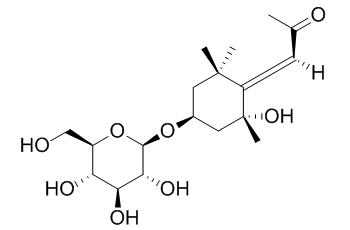Icariside B1
Icariside B1 shows inhibitory effects on LPS-induced NO production in RAW264.7 cells.
Inquire / Order:
manager@chemfaces.com
Technical Inquiries:
service@chemfaces.com
Tel:
+86-27-84237783
Fax:
+86-27-84254680
Address:
1 Building, No. 83, CheCheng Rd., Wuhan Economic and Technological Development Zone, Wuhan, Hubei 430056, PRC
Providing storage is as stated on the product vial and the vial is kept tightly sealed, the product can be stored for up to
24 months(2-8C).
Wherever possible, you should prepare and use solutions on the same day. However, if you need to make up stock solutions in advance, we recommend that you store the solution as aliquots in tightly sealed vials at -20C. Generally, these will be useable for up to two weeks. Before use, and prior to opening the vial we recommend that you allow your product to equilibrate to room temperature for at least 1 hour.
Need more advice on solubility, usage and handling? Please email to: service@chemfaces.com
The packaging of the product may have turned upside down during transportation, resulting in the natural compounds adhering to the neck or cap of the vial. take the vial out of its packaging and gently shake to let the compounds fall to the bottom of the vial. for liquid products, centrifuge at 200-500 RPM to gather the liquid at the bottom of the vial. try to avoid loss or contamination during handling.
Mol Biol Rep.2024, 51(1):117.
Adv. Anim. Vet. Sci.2024, 12(5):986-993.
Int J Mol Sci.2021, 22(11):5503.
Molecules.2023, 28(4):1526.
Int J Mol Sci.2022, 23(21):12816.
Food Science and Biotechnology2023, 2023:1007
Int J Mol Sci.2024, 25(20):11227.
Sci Rep.2024, 14(1):23786.
Int J Mol Sci.2024, 25(18):10219.
Molecules.2024, 29(22):5261.
Related and Featured Products
Abscisic acid
Catalog No: CFN90051
CAS No: 21293-29-8
Price: $40/20mg
8'-O-(3-hydroxy-3-methylglutaryl)-8'-hydroxyabscisic acid
Catalog No: CFN95308
CAS No: 69790-31-4
Price: $318/5mg
Breyniaionoside A
Catalog No: CFN96810
CAS No: 823182-23-6
Price: Inquiry(manager@chemfaces.com)
Cucumegastigmane I
Catalog No: CFN97498
CAS No: 929881-46-9
Price: $318/5
Apocynol A
Catalog No: CFN97750
CAS No: 358721-33-2
Price: Inquiry(manager@chemfaces.com)
Megastigm-7-ene-3,5,6,9-tetraol
Catalog No: CFN98335
CAS No: 680617-50-9
Price: Inquiry(manager@chemfaces.com)
7-Megastigmene-3,5,6,9-tetraol
Catalog No: CFN98334
CAS No: 276870-26-9
Price: Inquiry(manager@chemfaces.com)
Euscaphin B
Catalog No: CFN97536
CAS No: 956869-95-7
Price: Inquiry(manager@chemfaces.com)
Megastigm-7-ene-3,4,6,9-tetrol
Catalog No: CFN96244
CAS No: 180164-14-1
Price: Inquiry(manager@chemfaces.com)
cis-3,4-Dihydroxy-beta-ionone
Catalog No: CFN96404
CAS No: 875666-39-0
Price: Inquiry(manager@chemfaces.com)
Pharm Biol. 2015;53(11):1602-7.
Chemical constituents of the Annona glabra fruit and their cytotoxic activity.[Pubmed:
25856711]
METHODS AND RESULTS:
One new, (2E,4E,1'R,3'S,5'R,6'S)-dihydrophaseic acid 1,3'-di-O-β-d-glucopyranoside, and eight known compounds, (2E,4E,1'R,3'S,5'R,6'S)-dihydrophaseic acid 3'-O-β-d-glucopyranoside (2), icariside D2 (3), icariside D2 6'-O-β-d-xylopyranoside (4), 3,4-dimethoxyphenyl O-β-d-glucopyranoside (5), 3,4-dihydroxybenzoic acid (6), blumenol A (7), cucumegastigmane I (8), and Icariside B1 (9), were isolated from the fruits of A. glabra.
CONCLUSIONS:
Icariside D2 (3) was found to show significant cytotoxic activity on the HL-60 cell line with the IC50 value of 9.0 ± 1.0 μM and did not show cytotoxic activity on the Hel-299 normal cell line. The further test indicated that compound 3 induced apoptosis via alteration of expression of apoptosis-related proteins and decreased phosphorylation of AKT in HL-60 cells.
Bioorg Med Chem Lett. 2017 Feb 1;27(3):557-561.
Triterpene saponins and megastigmane glucosides from Camellia bugiamapensis.[Pubmed:
28011215 ]
METHODS AND RESULTS:
Two new triterpene saponins, camelliosides I and J (1 and 2), two new megastigmane glycosides, camellistigosides A and B (3 and 4), and two known megastigmane glycosides, Icariside B1 (5) and (6S,9R)-roseoside (6), were isolated from a methanol extract of the Camellia bugiamapensis leaves using various chromatographic separation techniques. Their structures were elucidated based on spectroscopic analyses, including HR ESI MS, CD, 1D and 2D NMR. Their inhibitory effects on LPS-induced NO production in RAW264.7 cells were evaluated.
CONCLUSIONS:
This is the first report of the chemical constituents and biological activity of C. bugiamapensis.
Yao Xue Xue Bao. 2014 Oct;49(10):1433-7.
Two new sulfated sesquiterpenoids from Petasites tricholobus.[Pubmed:
25577874]
METHODS AND RESULTS:
Two new sulfated sesquiterpenoids, megastigman-7-ene-3, 5, 6, 9-tetrol-3-O-β-D-6'-sulfonated-glucopyranoside (1) and 3-O-β-D-6'-sulfonated-glucopyranosyl-6-(3-oxo-2-butenylidenyl)-1, 1, 5-trimethylcyclohexan-5-ol (2), along with one known sesquitepenoid compound Icariside B1 (3) were isolated from the whole herb of Petasites tricholobus Franch. Their structures were identified by their chemical and spectroscopic characters.
CONCLUSIONS:
All obtained compounds were tested for their cytotoxicity against four cancer cell lines.



